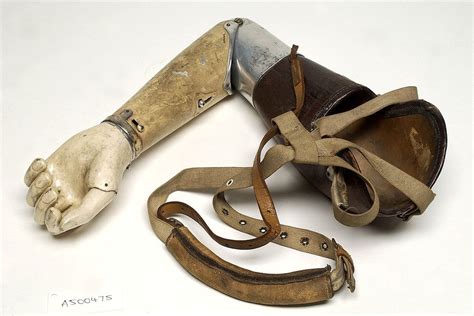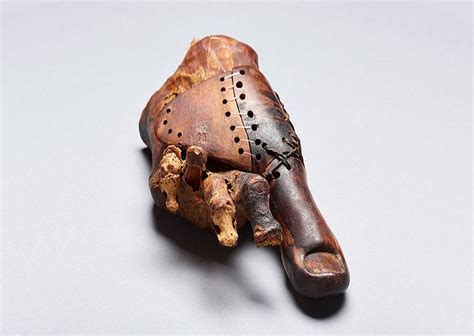artificial limbs of the tudor period | ancient prosthetic limbs artificial limbs of the tudor period An artificial leg recovered from a tomb in Capua in southern Italy, dated to the late fourth or early third century BC, had a wooden core covered in bronze sheeting. This was held .
Condo located at 30 Malta Ave Unit 505, Brampton, ON L6Y 4S5. View sales history, tax history, home value estimates, and overhead views.
0 · prosthetic limbs history
1 · oldest prosthetic limbs
2 · history of artificial legs
3 · etruscan prosthetic legs
4 · ancient prosthetic limbs
Dimensions: 24 x 17 x 8 cm / 9.5 x 6.5 x 3 inches. Other versions available. .
Fast forward 2000 years to what can only be described as the steampunk era of prosthetics. In France and Switzerland, from the late fifteenth through the nineteenth centuries, a variety of custom-designed limbs were built.In the discourses which circulate around the period’s most sophisticated prostheses, however, one can trace the functions – and therefore the bodily attributes – which were of most concern . Broca and Ducroquet’s book Artificial Limbs, part of a series called Military Medical Manuals produced in France in 1918, recommended that the spare limb be a peg leg, as it .War and industrialization drove the numbers in the Victorian history of artificial limbs, and mechanical utopianism drove the discourse. Many of the artificial limbs of the period were .
As surgeons explored surgical intervention with saws, amputees experimented with making artificial limbs. Wooden peg devices, as they’d been for centuries, remained common . An artificial leg recovered from a tomb in Capua in southern Italy, dated to the late fourth or early third century BC, had a wooden core covered in bronze sheeting. This was held .
From the late 15th century to the 19th century, France and Switzerland were making artificial limbs that could rotate and bend using cables, gears, cranks, and springs. .“Cork legs” developed a good deal over the course of the nineteenth century, with features such as ivory balls in rubber-socketed ankles for a fuller range of movement, whilst lightweight .

ysl dup belt
Summarizing our knowledge of artificial limbs in the era of antiquity, we have found evidence that wooden legs in the form of peg legs were built and used from earliest recorded times. The . Around 1900, the pioneers of prosthetic design had begun the idea of specialised artificial limbs. Limb design looked to more than just decorative uses and became increasingly .Artificial Limbs: A Review of Current Developments was an industry update of these research efforts and was published thirty-three times, spanning the years 1954 to 1972. . Researchers in the current era now will have a model of excellence for publications. All I can say is thanks to all who are involved in this project and to potential .of us - artificial limbs. Limbs may be absent at birth - as in the Thalidomide disaster of 1960, or even without it; or lost by disease, tumours or accident. Every artificial limb has to be worn by a human being who needs help and encour-agement in the period of adaptation to a com-pletely new form of use for everyday activities.
It is thought to be the earliest known practical artificial limb due to its flexibility and because it was refitted for the wearer multiple times. Approximately 300 years later—300 B.C.—in Italy, an ancient Roman nobleman used a prosthetic leg known as the “Capua leg.” The leg was made of bronze and hollowed-out wood and was held up . The portion of the prosthesis that fits snugly over the limb remnant, the “socket,” determines the amputee's comfort and ability to control the artificial limb. Since the 1980s prosthetic clinicians and researchers worldwide have made breakthroughs in design and materials that have greatly improved the connection between the socket and stump. Here are some facts about health and medicine in Tudor times. Tudor medicine mostly consisted of herbal remedies. For example, a mixture of sage, lavender and marjoram was recommended to treat a headache, chamomile was taken to help ease a stomach ache, and feverfew was consumed to help with colds and high-temperatures. Herbal remedies were [.] Today, 3D printing has introduced a new era of collaborative prosthetic limb design. In a commendable initiative, E-Nable Prosthetics is a project that puts volunteers with 3D printers in touch with handicapped children who need a hand prosthesis. Sources: (National Library of Medicine) (Premier Prosthetic) (ScienceDirect) (Smithsonian Magazine .
Replica of the Roman “Capua leg,” an artificial limb made of bronze (via Wikimedia Commons) . Fast forward 2000 years to what can only be described as the steampunk era of prosthetics. In France and Switzerland, from the late fifteenth through the nineteenth centuries, a variety of custom-designed limbs were built. .
The National Academy of Sciences, an American governmental agency, established the Artificial Limb Program in 1945. The program was created in response to the influx of World War II veteran amputees and for the purpose of advancing scientific progress in artificial limb development. Since this time, advances in areas such as materials, computer .
Another great Tudor surgeon was Ambroise Pare. In the 16th century, surgeons put oil on wounds. However in 1536 during the siege of Turin Pare ran out of oil. He made a mixture of egg whites, rose oil, and turpentine and discovered it worked better than oil. Pare also designed artificial limbs. Prosthetics or even known as artificial limbs is a device that helps users who have lost their limbs in an accident or due to some other reasons to regain an independent lifestyle. For e.g., if someone has lost his/her leg, an artificial leg or leg prosthetics is created so that the person can independently move. . After a long period of time .Last updated 01/2021 - You have reached a point in your journey where your residual limb is healing after your amputation and you are considering your options for a prosthesis. Thinking about your first prosthesis can be both an exciting and scary process. This will be another step in your journey toward returning to your new normal after surgery. It is important to make an . Usually that process takes several months and that time period won’t start until after your prosthetist determines that you’re fully healed from surgery. Artificial limbs are a lifesaver for many Americans, providing a quality of life that they wouldn’t have otherwise. The journey to getting there is a tough road, but worth it for the .
To replace the functionality of the amputated limb, Par e wrote works about artificial limbs he fitted on his amputees (Fig. 5). 23 However, excessive blood loss was still a common complication .
Many of the artificial limbs of the period were designed and made by artisans, men who worked with tools and machines for a living and took a craftsman’s approach to the problem. Their solutions employed springs, levers, wheels, trusses, pulleys, pneumatic extensions, hydraulic force, leather, carved and polished wood (preferably willow . Fast forward 2000 years to what can only be described as the steampunk era of prosthetics. In France and Switzerland, from the late fifteenth through the nineteenth centuries, a variety of custom-designed limbs were built.In the discourses which circulate around the period’s most sophisticated prostheses, however, one can trace the functions – and therefore the bodily attributes – which were of most concern to artificial limb users and makers.
Broca and Ducroquet’s book Artificial Limbs, part of a series called Military Medical Manuals produced in France in 1918, recommended that the spare limb be a peg leg, as it could be purchased by poor patients who could not afford two full legs.
War and industrialization drove the numbers in the Victorian history of artificial limbs, and mechanical utopianism drove the discourse. Many of the artificial limbs of the period were designed and made by artisans, men who worked with tools and machines for a living and took a craftsman’s approach to the problem. As surgeons explored surgical intervention with saws, amputees experimented with making artificial limbs. Wooden peg devices, as they’d been for centuries, remained common lower limb.
An artificial leg recovered from a tomb in Capua in southern Italy, dated to the late fourth or early third century BC, had a wooden core covered in bronze sheeting. This was held in place by a. From the late 15th century to the 19th century, France and Switzerland were making artificial limbs that could rotate and bend using cables, gears, cranks, and springs. However, these devices still needed to be adjusted manually.“Cork legs” developed a good deal over the course of the nineteenth century, with features such as ivory balls in rubber-socketed ankles for a fuller range of movement, whilst lightweight leather prosthetics were also developed which could be laced on like knee boots.
Summarizing our knowledge of artificial limbs in the era of antiquity, we have found evidence that wooden legs in the form of peg legs were built and used from earliest recorded times. The wooden leg was designed mostly for loss of limb below the knee.
prosthetic limbs history

Oversized Joggers & Sweatpants (11) Hide Filters. Sort By. Best Seller. Nike Sportswear Phoenix Fleece. Women's High-Waisted Oversized Sweatpants. 8 Colors. $70. Best Seller. Nike Sportswear Club Fleece. Women's Mid-Rise Oversized Sweatpants. 5 Colors. $60. Nike Sportswear Club Fleece. Women's Mid-Rise Oversized Cargo Sweatpants. 4 .
artificial limbs of the tudor period|ancient prosthetic limbs

























